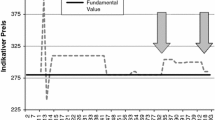Abstract
We analyze how the market processes a signaling event by studying a sample of self-tender offers, events often viewed as signals of firm value. By examining changes in the degree of informed trading, we find asymmetric information costs fall at announcement, remain low throughout the event, and increase at offer expiration. By one month following expiration, informed trading returns to a level not significantly different from that prior to the offer. Higher risk firms have significantly larger declines in information asymmetry during the offer. Increases in information asymmetry persist one month following expiration for firms with lower pre-offer informed trading. (JEL G14, G32)
Similar content being viewed by others
References
Ahn, H., C. Cao, and H. Choe. 2001. “Share Repurchase Tender Offers and Bid-Ask Spreads.”Journal of Banking and Finance 25: 445–478.
Bartov, E. 1991. “Open-Market Stock Repurchases as Signals for Earnings and Risk Changes.”Journal of Accounting and Economics 14: 275–294.
Brennan, M.J. and A. Subrahmanyam. 1995. “Investment Analysis and Price Formation in Securities Markets.”Journal of Financial Economics 38: 361–381.
Comment, R. and G.A. Jarrell. 1991. “The Relative Signaling Power of Dutch-Auction and Fixed-Price Self-Tender Offers and Open-Market Share Repurchases.”Journal of Finance 46: 1243–1271.
Dann, L.Y. 1981. “The Effects of Common Stock Repurchase on Security Holders’ Returns.”Journal of Financial Economics 9: 111–138.
Dann, L.Y., R.W. Masulis, and D. Mayers. 1991. “Repurchase Tender Offers and Earnings Information.”Journal of Accounting and Economics 14: 217–252.
Easley, D., N.M. Kiefer, M. O’Hara, and J.B. Paperman. 1996. “Liquidity, Information, and Infrequently Traded Stocks.”Journal of Finance 51: 1405–1436.
Easley, D., M. O’Hara, and J.B. Paperman. 1998. “Financial Analysts and Information-Based Trade.”Journal of Financial Markets 1: 175–210.
Forjan, J.M. and M.S. McCorry. 1997. “Adverse Information and Dealer Spreads: Evidence from Dutch-Auction Repurchases.”The Financial Review 32: 729–750.
Gervais, S., R. Kaniel, and D.H. Mingelgrin. 2001. “The High-Volume Return Premium.”Journal of Finance 56: 877–919.
Glosten, L.R. and L.E. Harris. 1988. “Estimating the Components of the Bid / Ask Spread.”Journal of Financial Economics 21: 123–142.
Hertzel, M. and P.C. Jain. 1991. “Earnings and Risk Changes around Stock Repurchase Tender Offers.”Journal of Accounting and Economics 14: 253–274.
Ho, T.S.Y. and R.G. Macris. 1984. “Dealer Bid-Ask Quotes and Transactions Prices: An Empirical Study of Some AMEX Options.”Journal of Finance 39: 23–45.
Hodrick, L. S. 1999. “Does Stock Price Elasticity Affect Corporate Financial Decisions?”Journal of Financial Economics 52: 225–256.
Judge, G.G., R.C. Hill, W.E. Griffiths, H. Lutkepohl, and T. Lee. 1988.Introduction to the Theory and Practice of Econometrics 2nd Ed., John Wiley & Sons, Incorporated, Hoboken, NJ.
Lee, C.M.C. and B. Swaminathan. 2000. “Price Momentum and Trading Volume.”Journal of Finance 55: 2017–2069.
Lie, E. and J.J. McConnell. 1998. “Earnings Signals in Fixed-Price and Dutch-Auction Self-Tender Offers.”Journal of Financial Economics 49: 161–186.
Madhavan, A. and S. Smidt. 1991. “A Bayesian Model of Intraday Specialist Pricing.”Journal of Financial Economics 30: 99–134.
Noronha, G.M., A. Sarin, and S.M. Saudagaran. 1996. “Testing for Micro-Structure Effects of International Dual Listings Using Intraday Data.”Journal of Banking and Finance 20: 965–983.
O’Hara, M. 1997.Market Microstructure Theory. Blackwell Publishing, Cambridge, Massachusetts.
O’Neill, M. and J. Swisher. 2002. “Institutional Investors and Information Asymmetry: An Event Study of Self-Tender Offers.”The Financial Review 38: 197–211.
Roll, R. 1984. “A Simple Implicit Measure of the Effective Bid-Ask Spread in an Efficient Market.”Journal of Finance 39: 1127–1139.
Author information
Authors and Affiliations
Corresponding author
Rights and permissions
About this article
Cite this article
O’Neill, M., Swisher, J. How useful are signals? A micro-structure analysis. J Econ Finan 31, 331–340 (2007). https://doi.org/10.1007/BF02885723
Issue Date:
DOI: https://doi.org/10.1007/BF02885723




